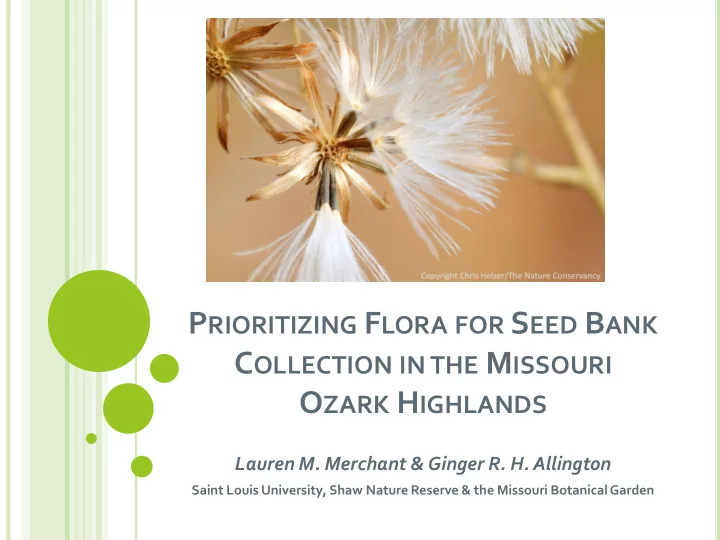

P RIORITIZING F LORA FOR S EED B ANK C OLLECTION IN THE M ISSOURI O ZARK H IGHLANDS Lauren M. Merchant & Ginger R. H. Allington Saint Louis University, Shaw Nature Reserve & the Missouri Botanical Garden
C URRENT C ONSERVATION N EEDS
W HAT I S A S EED B ANK ? Exactly like what it sounds! Long-term preservation of seeds Stored at low temperatures (-18° C / 0° F)
B ENEFITS OF SEED BANKING Long-term preservation of genomes to prevent genetic diversity loss Collaboration Source for future biological research Source for future conservation efforts Conserve Species Conserve Space
T HE S HAW N ATURE R ESERVE S EED B ANK
A S HORT H ISTORY OF M ISSOURI Glacial refuge Sea Levels Some areas never exposed to either Many endemic species
O ZARK H IGHLANDS : T HE F IST P HASE OF C OLLECTION Most Diverse Region of Missouri
Q UESTION … What species should take priority when deciding where and when to collect seeds? (> 2,000 Native Flowering Plants in Missouri)
Full list of Missouri’s native flowering plants Species distribution information Weighed on a scale from 0 – 10 (19 = 10)
Updated Coefficients of Conservatism Estimated based on: Tolerance to disturbance Frequency Amplitude Fidelity Assigned an integer from 0 – 10 (10 = highly conservative species) Weighed on a scale from 0 – 10
Conservation Status State Rankings Weighed on a scale from 1 – 10 SH = 10, S1 = 8, S2 = 6, … Global Rankings Weighed on a scale from 1 – 10 G5 = 0, G4 = 2, G3 = 4 Note: G1 and G2 species removed
All data merged into one spreadsheet using Microsoft Excel Topicos Database used to resolve taxonomic conflicts. The Missouri Department of Conservation’s Species of Concern Checklist (Jan 2013 issue) used to fill in missing data.
S NAPSHOT OF THE SPREADSHEET
*Note: “Other” state rankings removed
W HAT W E N OW H AVE : Methodology for prioritizing within the remaining eco-regions A resource that encourages collaboration A more focused project
F UTURE OF THE S HAW N ATURE R ESERVE S EED B ANK Identification of the first county for collection Collection, processing, storage and curating! Ginger needs more interns!! ;)
F INAL C ONSIDERATIONS Ethics: Seed collection proportionate to population Seed usage must be well researched and planned before use Challenges: Avoiding a “bottle neck” effect Proper preparation for storage Key elements of successful Ex Situ program: Collection from different populations and micro-habitats Detailed collection notes Proper storage, planning, and precautions. Viability assessed at regular intervals
A CKNOWLEDGEMENTS Doug Ladd Dr. David Bogler Justin Zweck Rebecca Landewe My fellow REU students!
L ITERATURE C ITED AND C ONTACT I NFORMATION Ginger R. H. Allington Missouri Natural Heritage Program. 2013. Missouri species and communities of conservation concern checklist. Missouri Botanical Gardens Missouri Department of Conservation. Jefferson City, Missouri. pp. 52. ginger.allington@mobot.org NatureServe Explorer: An Online Encyclopedia of Life. 23 July 2013. <http://www.natureserve.org/explorer/ index.htm>. Lauren M. Merchant Raven, P. H. (2004). Ex Situ Plant Conservation: Supporting Species Survival In The Wild. E. O. Saint Louis University Guerrant, K. Havens, & M. Maunder (Eds.). Island Press. lmerchan@slu.edu Taft, J. B., et al. 2013. Floristic Quality Assessment For Vegetation in Illinois: A Method for Assessing Vegetation Integrity. (Pending Publication) Tropicos. 23 July 2013.<http://www.tropicos.org/>. USDA PLANTS. 23 July 2013. <http://plants.usda.gov/>.
Recommend
More recommend